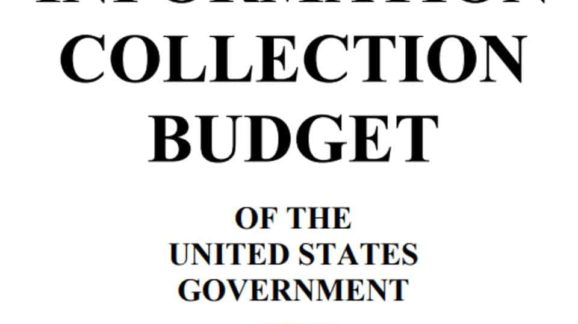Federal Paperwork Consumes The Equivalent Of 16,267 Human Lifetimes
As the latest edition of the federal Information Collection Budget of the United States Government(ICB) from the White House Office of Management and Budget (OMB) shows, red tape is still a thing. But it may be getting better.
The OMB has released its annual federal paperwork burden survey since passage of the Paperwork Reduction Act back in 1980.
But by “latest,” I mean the 2017 edition covering fiscal year 2016, which actually falls under the Obama administration timeframe. It’s no surprise to anyone that federal reports can be late, though. The 2015 and 2016 editions did not appear until December 2019. The 2017 edition slipped in there in February 2020.
This means we don’t yet have the official report on paperwork burdens and pencil pushing under the Trump Administration. There are partial workarounds regarding that, though; it is possible to track paperwork hours on an OMB database, as well as with the RegRodeo tool at the American Action Forum.
Given the Trump administration’s wide range of regulatory liberalization moves such as the elimination of two rules for every significant one added, it is reasonable to expect some red tape relief; we’ll circle back to that later in the year when we likely see newer ICBs.
For present purposes, though, the public in 2016 spent an estimated 11.4 billion hours dealing with paperwork and information collections. The Trump administration’s OMB has improved the ICB, as the new edition covers 36 agencies rather than 28 federal agencies as the prior one did.
In so doing, compliance hours attributable to the Dodd-Frank law and its affiliated agency paperwork and certain other federal activities once exiled to an appendix on the last page of the ICB now appear in the primary portion of the ICB. Nearby appears the breakdown by agency
The Treasury Department and tax compliance dominate the federal paperwork burden show with 8.1 billion hours. The 1.4 billion hours attributable to the Department of Health and Human Services come in at a distant second.

For some context, the 11.4 billion hours required to complete federal paperwork and information collection is up from 2016’s 9.8 billion, 2011’s 8.8 billion, and 2000’s 7.4 billion. There’s a lot more paperwork now, but also more agencies get surveyed. And much of the paperwork is driven by recent sweeping legislation rather than regulation, so Trump’s unilateral power to cut it is going to be limited.
How does one visualize 11.4 billion hours? Here’s one way. An 80-year human lifespan amounts to 29,200 days. That’s 700,800 hours (Here’s an animation).
That means the 2017 ICB’s 11.4 billion hours of paperwork took up the equivalent of 16,267 human lifetimes. That’s up from 13,953 full human lifetimes in the 2016 report.
Those subject to paperwork might say the federal government underestimates it. Other compliance costs, tasks, duties, restrictions, directives, mandates, distractions and time-sucks are not included. Not everyone lives 80 years (it’s 78.6 years on average), which would make paperwork “cost” more. Surely most of us surely would prefer not to spend too much of our finite 700,000 hours on federal paperwork unnecessarily.
OMB does present cost savings some agencies claim in “burden reduction initiatives” across agencies, and we might anticipate additional progress on these in the wake of Trump’s executive orders on regulatory reduction.
The OMB does not provide annual cost estimates for all these hours, but way back in the 2011 edition of the ICB it was noted that “if each hour [then 8.783 billion] is valued at $20, the monetary equivalent would be $176 billion.”
In a report called When Paperwork Attacks! Five Ideas for Smarter Government, the Progressive Policy Institute noted the $20 figure which would, at that time, position “paperwork” at number five in the Fortune 500 based on “revenues” equivalence.
A corresponding burden in dollar terms for the 2017 report would be $228 billion (11.4 billion hours times $20). Of course, it’s been a while since a lawyer or compliance officer was hired for $20 per hour. An installment of this roundup a few years back noted the high salaries of specialists in banking and in environmental compliance. Assuming $40 an hour, that would mean over $456 billion in paper-shuffling costs not counting actual compliance with and economic/social impacts of the underlying rules and regulations generating the paper in the first place.
The real figure may be somewhere in the middle. The National Federation of Independent Business conducts a survey of members with respect to paperwork compliance costs. Meanwhile, the Bureau of Labor Statistics notes the following mean hourly wages (the median is lower) for basic categories one might regard as relevant in keeping up with complex federal paperwork. All exceed the $20 floated by OMB.
The hours and dollar costs of federal information collection are substantial and bear more scrutiny. Perhaps before 2020 ends we’ll get the figures for 2018-20 and be able to use what we discover in further red tape reductions. A substantial amount of regulation has been deemed “never needed” during the Covid-19 crisis, and similar analysis for federal paperwork will be worthwhile alongside.
